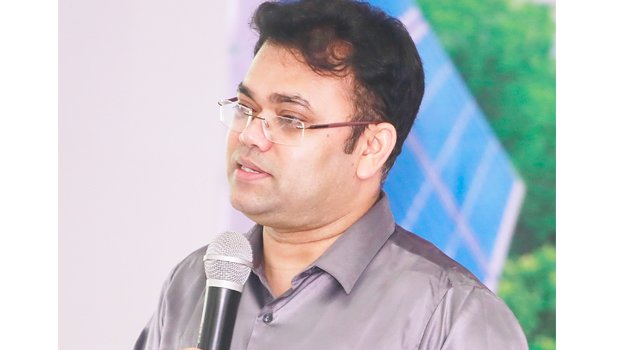Annual Banking Conference 2019
Sustainable dev through financial inclusion drives

Dr. Shah Md Ahsan Habib
Sustainable development rests beyond growth. The developmental changes are associated with enriched human wellbeing and social equity while significantly minimizing environmental risks. The approach of sustainable growth is very much within the broader scope of sustainable development goals (SDGs) of the United Nations (UN) that are expected to address and integrate different dimensions. To attain that banks, have a great role to play and the sustainable action by banks goes beyond profitability. Alongside targeting profitability, through sustainable financing activities a bank or financial institution aims at addressing qualities of profitability in economic, social and environmental fronts. Sustainable financing cannot be desegregated from the key concerns of corporate governance and corporate social responsibility practices by banks, and economic and financial inclusion of the vulnerable sections of the society.
Traditional finance focuses solely on financial return and risk, whereas sustainable finance considers financial, social and environmental returns in combination of highlighting the move from the narrow shareholder model to the broader stakeholder framework, aimed at long-term value creation for the wider community. However, in the context of different countries and perspectives, the concept may be interpreted narrowly and broadly. In spite of differences in perceptions and scopes, the available recent literature perceive the concept broadly as compared to the earlier age, and it is most commonly now tagged with long term goals associated with economic, environmental and social aspects.
One key policy concern related to sustainable finance is the financial exclusion, and the finance to be sustainable must address financial exclusion challenge at the individual and macro level. It is recognized that access to finance can economically and socially empower individuals, in particular poor people, allowing them to better integrate themselves into the economy, to contribute to their development and to protect themselves against economic shocks. Financial inclusion could perform as a major force for the reduction of poverty by reducing inequalities. There are proven evidences that a small loan, a savings account or a micro insurance policy can make great difference to a low-income individual or a family. In addition, access to financial services is often viewed as essential factors like access to safe water, health services and primary education, in order to ensure participation of common people in the activities of the economy. Financial inclusion issues are clearly associated with the social and economic inclusion issues of women as well. Considering the socio-economic benefits, agriculture and small or micro enterprise financing cannot be delinked from the scope of the sustainable finance in the context of most developing countries. In most instances, the progression of agriculture and micro enterprise sectors is associated with the socio-economic advancement of the vulnerable and low-come sections of the society. There is no doubt that designing effective financing products and delivery channels are crucial in attaining better outcome in these endeavors. And in this context, use of technology and digital financial services might bring remarkable change.
On the way to address financial exclusion, Bangladesh is currently engaged in the formulation of National Financial Inclusion Strategy (NFIS), which is expected to be enforced by 2020. In order to deepen financial inclusion, Bangladesh Bank (BB) has launched a separate department named ‘Financial Inclusion Department’ in 2015. Moreover, BB instructed schedule banks to open bank accounts for destitute people and low-income groups and allocated funds for offering small credit facilities. BB has been encouraging information technology and innovation to bring the vast unbanked/under-banked population under the umbrella of formal financial service though bank-led mobile financial services (MFS). The Central Bank is working to facilitate and introduce e-KYC and banks are now allowed to verify the national identity card of their clients through using the NID data base.
BB has been encouraging information technology and innovation to bring the vast unbanked/under-banked population under the umbrella of formal financial service though bank-led mobile financial services (MFS). Disbursement of inward foreign remittance and domestic fund; payment of utility bills, salary, allowances, pension; buying and selling of goods and services; balance inquiry; tax payment; Government subsidy payment and payment of the benefits of social safety nets can easily and quickly be provided through mobile financial services. By the time over 50 percent banks have been permitted to offer MFS services through bank-agents countrywide. MFS has created an opportunity of fast and cost- effective transaction even to the remotest corner of the village as well as it has given access to modern banking services to the rural poor including the social safety net beneficiaries. Through the issuance of agent banking guidelines, BB attempted greater access to banking services. Success of agent and booth banking might be remarkable forces on the way to take the banking system to a new height in the near future. Banks need demand-based products targeting rural low-income population. Digital financial services might contribute remarkably in this context.
BB has been very active in supporting commercial banks in undertaking financial literacy events. Regarding promotion of financial literacy, BB directed all the scheduled banks to start a financial inclusion policy for school-going students under the name of school banking in 2010. The policy guidelines for school banking, circulated by the BB, suggested participating banks to provide educational insurance facility to account holders. Currently BB is working to formulate a Financial Literacy Guideline for banks and financial institutions. In is recognized that limited knowledge, awareness, and capacity on the inclusive and digital finance interventions and products are critical challenges. Bankers, especially who are engaged at the branch/field level and the intermediaries/suppliers must be motivated and need exposure on the use, benefits and technical aspects of inclusive products. It is likely that the customers do not have familiarity with the products and it is even possible that they haven’t heard of a product at all. The financial industry also needs support from researchers and academicism’s who are engaged in the process of supporting inclusive and digital banking in the country. BIBM initiated the two day-long gathering ‘Annual Banking Conference 2019’ aiming at bringing together experts, academicians and researchers to exchange and share knowledge, experience and research outputs on banking and related issues. It is for the eighth time that the BIBM is organizing the event. This is really inspiring for BIBM and also personally for me. Back in 2011, BIBM’s the then management and Governing Board responded positively to my proposal and conceptualization for having a platform of knowledge sharing amongst bank practitioners, researchers, and academicians. The second day is designed to concentrate on the macroeconomic issues



